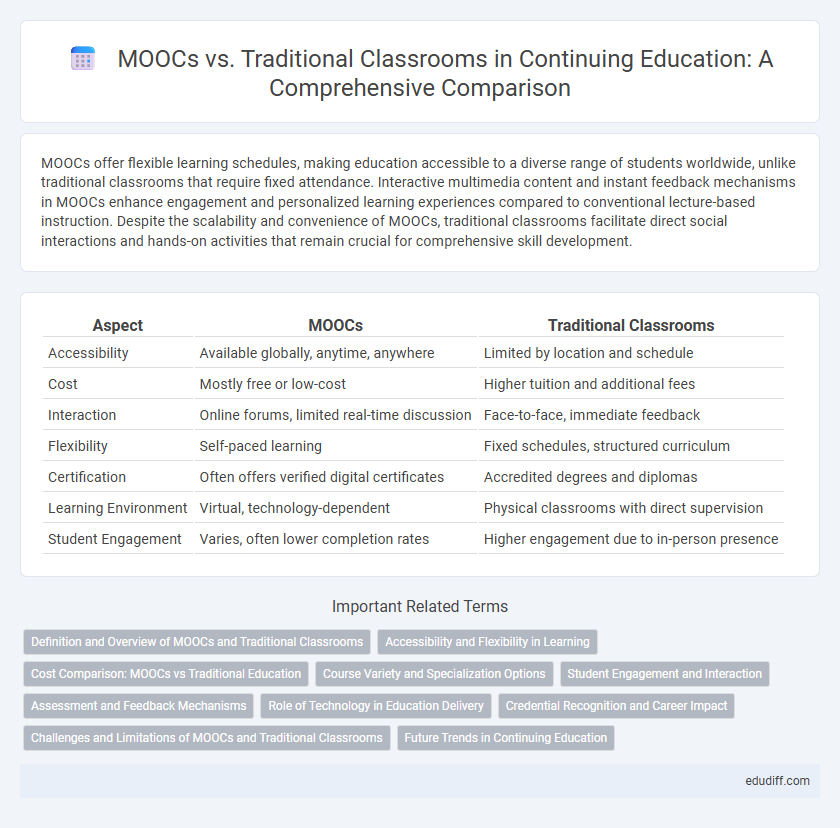MOOCs offer flexible learning schedules, making education accessible to a diverse range of students worldwide, unlike traditional classrooms that require fixed attendance. Interactive multimedia content and instant feedback mechanisms in MOOCs enhance engagement and personalized learning experiences compared to conventional lecture-based instruction. Despite the scalability and convenience of MOOCs, traditional classrooms facilitate direct social interactions and hands-on activities that remain crucial for comprehensive skill development.
Table of Comparison
| Aspect | MOOCs | Traditional Classrooms |
|---|---|---|
| Accessibility | Available globally, anytime, anywhere | Limited by location and schedule |
| Cost | Mostly free or low-cost | Higher tuition and additional fees |
| Interaction | Online forums, limited real-time discussion | Face-to-face, immediate feedback |
| Flexibility | Self-paced learning | Fixed schedules, structured curriculum |
| Certification | Often offers verified digital certificates | Accredited degrees and diplomas |
| Learning Environment | Virtual, technology-dependent | Physical classrooms with direct supervision |
| Student Engagement | Varies, often lower completion rates | Higher engagement due to in-person presence |
Definition and Overview of MOOCs and Traditional Classrooms
Massive Open Online Courses (MOOCs) are digital learning platforms offering accessible, flexible education to a global audience through video lectures, quizzes, and peer interactions. Traditional classrooms involve in-person instruction within a physical setting, emphasizing direct student-teacher engagement and structured schedules. Both modes facilitate knowledge acquisition but differ significantly in delivery, scalability, and learner interaction.
Accessibility and Flexibility in Learning
MOOCs provide unparalleled accessibility, enabling learners worldwide to access high-quality courses without geographic or financial barriers. Traditional classrooms often demand fixed schedules and physical presence, limiting flexibility for students balancing work, family, or other responsibilities. The asynchronous nature of MOOCs allows learners to progress at their own pace, accommodating diverse learning styles and time constraints.
Cost Comparison: MOOCs vs Traditional Education
MOOCs offer significantly lower costs compared to traditional education, often providing free access to high-quality courses from top universities worldwide. Traditional classrooms typically involve substantial expenses such as tuition fees, accommodation, textbooks, and commuting, which can amount to thousands of dollars annually. The cost-efficiency of MOOCs makes them an attractive option for learners seeking flexible and affordable education solutions.
Course Variety and Specialization Options
Massive Open Online Courses (MOOCs) offer an extensive range of courses across diverse fields, enabling learners to explore niche topics and specialized subjects often unavailable in traditional classrooms. Traditional education institutions typically provide a more limited selection of courses, constrained by faculty expertise and curriculum requirements. MOOCs facilitate personalized learning paths and continuous skill development through flexible specialization options that adapt to evolving industry demands.
Student Engagement and Interaction
MOOCs leverage interactive forums, live Q&A sessions, and peer review systems to boost student engagement beyond traditional classroom limitations. Unlike face-to-face settings, MOOCs offer flexible participation and diverse multimedia resources that cater to different learning styles. Data shows that well-designed MOOCs can match or exceed traditional classes in fostering active learning and collaborative interaction.
Assessment and Feedback Mechanisms
MOOCs utilize automated quizzes and peer reviews to provide immediate assessment and diverse feedback, enhancing learner autonomy and scalability. Traditional classrooms rely on instructor-led evaluations and personalized feedback, fostering deeper understanding through direct interaction. The integration of adaptive learning technologies in MOOCs increasingly narrows the gap with traditional assessment quality.
Role of Technology in Education Delivery
Technology transforms education delivery by enabling MOOCs to offer flexible, scalable learning experiences accessible worldwide, surpassing the geographic and scheduling limitations of traditional classrooms. Advanced platforms incorporate interactive tools, video lectures, and real-time assessments, enhancing student engagement and personalized learning paths. Traditional classrooms increasingly integrate digital resources and hybrid models, but technology remains central to the expansive reach and adaptive capabilities characteristic of MOOCs.
Credential Recognition and Career Impact
MOOCs offer flexible learning paths with certificates that increasingly gain recognition from employers, especially in tech and digital industries, while traditional classroom degrees remain the standard for many professional fields due to their established credibility. Employers often value the practical skills and up-to-date knowledge gained through MOOCs but still prefer accredited degrees for roles requiring formal qualifications. Career advancement can benefit from MOOCs that provide specialized, industry-relevant credentials, complementing traditional education rather than fully replacing it.
Challenges and Limitations of MOOCs and Traditional Classrooms
MOOCs face challenges such as limited student engagement, high dropout rates, and inadequate personalized feedback compared to traditional classrooms, which offer direct interaction and immediate clarification. Traditional classrooms often struggle with inflexible scheduling, geographic constraints, and higher costs, limiting accessibility for many learners. Both education models require improvements in engagement strategies and resource allocation to enhance overall learning effectiveness.
Future Trends in Continuing Education
Future trends in continuing education emphasize the integration of MOOCs and traditional classrooms through hybrid models that leverage digital platforms for personalized learning. Artificial intelligence and adaptive learning technologies are enhancing content delivery, enabling learners to progress at individualized paces while maintaining interaction with instructors. The growing demand for flexible, skill-based education drives institutions to adopt competency-based frameworks, blending online and face-to-face experiences to prepare learners for evolving workforce needs.
MOOCs vs Traditional Classrooms Infographic

 edudiff.com
edudiff.com